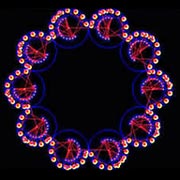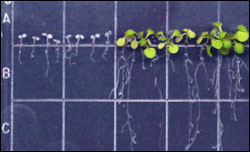
A European team of scientists from the University of Dundee (UK), the Technical University of Munich (Germany) and the European Synchrotron Radiation Facility, ESRF, (France) have determined the structure of a key target enzyme for novel drug development to treat infectious diseases including malaria, tuberculosis and sexually transmitted bacterial infections. The results of their collaboration are published on the August 5 issue of Proceedings of the National Academy of Sciences.
Synchrotr

It will never be the same old song again–this was the concept for MS3, a Hungarian musician when he created a software solution he calls „digital improvisation” or DI. The „di” music file format he developed enables the users to listen to one song in endless number of versions. „Imagine Madonna’s new releases were recorded in di format. Whenever you hit the ’’Play’’ button, a different remix of the same song is played back. You never get bored of your cd then” said Mester, now hea

Simulate Network Traffic from over 1 Million Web Browsers in Near Real Time
Researchers at the Georgia Institute of Technology have created the fastest detailed computer simulations of computer networks ever constructed—simulating networks containing more than 5 million network elements. This work will lead to improved speed, reliability and security of future networks such as the Internet, according to Professor Richard Fujimoto, lead principal investigator of the DARPA-funded projec

Moore´s Law – a dictum of the electronics industry that says the number of transistors that fit on a computer chip will double every 18 months – may soon face some fundamental roadblocks. Most researchers think there´ll eventually be a limit to how many transistors they can cram on a chip. But even if Moore´s Law could continue to spawn ever-tinier chips, small electronic devices are plagued by a big problem: energy loss, or dissipation, as signals pass from one transistor to the next. Line up all t

New use for seismic reflection data: revealing the most dangerous fault lines on Earth
Researchers have found an important new application for seismic reflection data, commonly used to image geological structures and explore for oil and gas. Recently published in the journal Nature, new use of reflection data may prove crucial to understanding the potential for mega earthquakes.
Mladen Nedimovic, the lead author and a scientist at the Lamont-Doherty Earth Observatory, a membe

Researchers at the University of California, San Diego have demonstrated that a chemical that permits plants to detoxify heavy metals can be transported from the roots to stems and leaves, a finding that brings the possibility of using plants to clean up soil contaminated with toxic metals such as lead, arsenic and cadmium one step closer to reality.
A paper detailing the discovery appears this week in an advance online publication of the Proceedings of the National Academy of Science

In the 1997 movie “Contact,” adapted from Carl Sagan’s 1985 novel, the lead character scientist Ellie Arroway (played by actor Jodi Foster) takes a space-alien-built wormhole ride to the star…

NASA’s Coronal Diagnostic Experiment (CODEX) is ready to launch to the International Space Station to reveal new details about the solar wind including its origin and its evolution. Launching in…

In space exploration, long-distance optical links can now be used to transmit images, films and data from space probes to Earth using light. But in order for the signals to…

There is fresh momentum in our protein supply — and it’s moving along on six legs. Insects are a source of protein with a smaller resource footprint than conventional alternatives…

A research team led by Prof. JIANG Hailong, Prof. LUO Yi, and Prof. JIANG Jun from the University of Science and Technology of China (USTC) discovered a metal-organic framework (MOF)…

Research led by the University of Michigan has provided compelling evidence that could solve a fundamental mystery in the makeup of fibrils that play a role in Alzheimer’s, Parkinson’s and…

Thermoplastic blends, produced by a new process, have better resilience. Now, experiments at the IRIS beamline show, why: nanocrystalline layers increase their performance. Bio-based thermoplastics are produced from renewable organic…

MXene nanomaterials enable wireless charging in textiles. Researchers demonstrate printed textile-based energy grid using MXene ink. The next step for fully integrated textile-based electronics to make their way from the…

Takeout containers get your favorite noodles from the restaurant to your dining table (or couch) without incident, but they are nearly impossible to recycle if they are made from foil-lined…

TU researchers enable better protection for sending sensitive information. In today’s digital landscape, ensuring the privacy of online communications is more critical than ever, especially in professions that rely on…

Researchers discover new magnetic and electronic properties in kagome magnet thin films. A discovery by Rice University physicists and collaborators is unlocking a new understanding of magnetism and electronic interactions…

– Wireless Aggregation of Health Data. Health data, distributed across various applications, could be unified in a digital medical twin: This is how doctors could improve patient care with the…